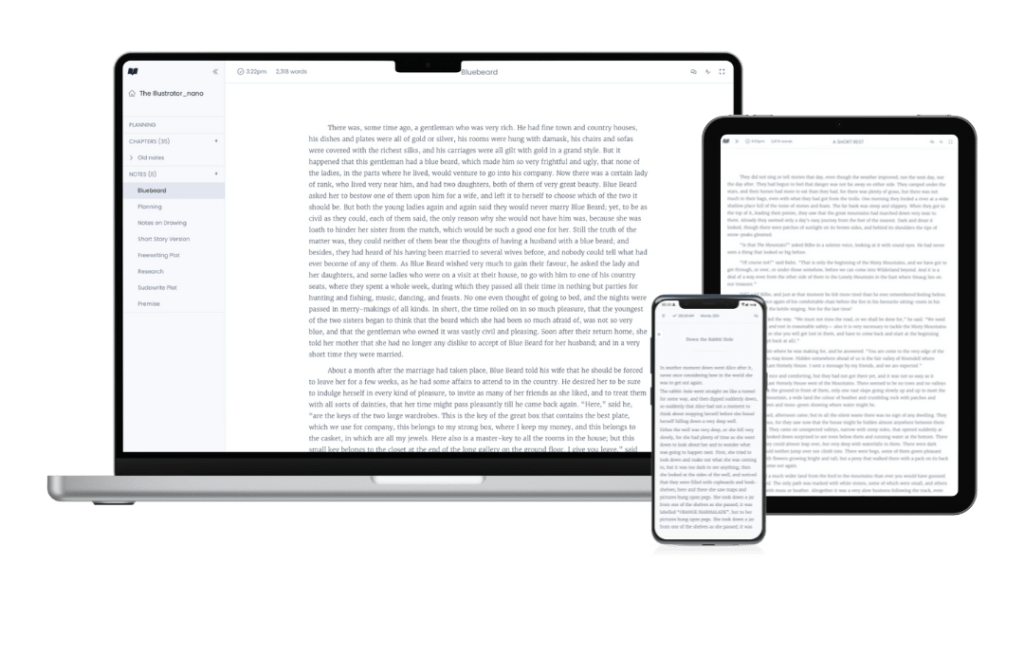
Choosing Your Narrative Voice: Which Option is Right for You?

One of the most important elements to consider when writing is narrative voice. Narrative voice is the way in which you tell your story and is important in every style of writing, whether it’s fiction or non-fiction, poetry, or short stories. Each type of narrative voice has its own set of pros and cons that will impact how readers will internalise your work, so choosing the point of view that will best serve your work is an important part of the writing process.
What is narrative voice?’
In simple terms, narrative voice is the way you tell your story. It defines the point of view of everything you write, and will be critical in how a reader experiences what you’re trying to tell them.
For me, the main inspiration to write a story or novel is the voice of its central character, or the narrative voice of the story itself.
Scott Bradfield
It’s good to decide on your narrative voice before you start writing, as your choice will set the tone for everything else. Not having a clear vision for voice and tone when you start can result in inconsistencies or repeated work if you change your mind halfway through.
When deciding on a narrative voice, make sure you’ve outlined your novel first and decided on protagonists. Weigh up all your options carefully by being clear on the message you want your readers to take away. Write a list of pros and cons based on how the different narrative points of view can serve that message. Within that, also look carefully at which character could serve as a potential narrator, as that can make a huge difference to the style of story you write.
As an example, To Kill a Mockingbird by Harper Lee has Scout as the narrator. The reader experiences the book through a child’s perspective and memories, which changes the tone and the way the information is presented hugely than if Atticus Finch had been the narrator.

First-Person Point of View
First-person point of view is when the story is told from the narrator’s perspective. It creates a sense of intimacy with the reader as the scope of the narrative is limited to only a specific character’s experiences.
The pronouns you’ll usually see written for this narrative voice are first person singular (I/me/my) or first person plural (we/us/ours), but singular is the most common. It is an especially good point of view for dialogue-heavy books as it reads as more conversational – the dialogue is often peppered with the narrator’s internal monologue.
First-person narratives are also good for heightening a reader’s emotional investment in a book’s characters. Because they are intimately connected to the character’s internal life, readers also experience the narrator’s relationships with, creating an emotional bond that is not always present in other narrative viewpoints.
A great example of the use of first-person is The Virgin Suicides by Jeffrey Eugenides. His first-person plural narration, from the point of view of a group of boys who knew the Lisbon sisters, creates a sense of mystery around the girls’ deaths and focuses on the ultimate unknowability of someone else’s internal life.
When I wrote The Virgin Suicides, I gave myself very strict rules about the narrative voice: the boys would only be able to report what they had seen or found or what had been told to them.
Jeffrey Eugenides
Because all events in a first-person narrative are seen and experienced through the narrator’s eyes, they are biased by default. This can create interesting stories through the use of subjective experience and unreliable narration.
Second-Person Point of View
Second-person point of view is the least used narrative voice in fiction but can be very effective when used correctly. Second-person is when the narrator speaks directly to the reader, who is referred to with the pronouns “you” or “your”.
Despite being common in fiction, second-person narrative voice is most often used in non-fiction. You’ll regularly see it in business books, how-to guides, or self-help books where the writer is talking directly to the reader to give them instruction. In fiction, however, it can be much more difficult to use well.
Second-person narration can be used to make the reader feel like they are a part of the story. A good example is Louise Doughty’s Apple Tree Yard. The story opens in the second person and creates a compelling mystery around who has been murdered and why. The use of “you” puts the mystery front and centre of the story, but obscures the resolution until Doughty is ready to reveal it.
The first day without you is painful in a way that is almost exquisite. I imagine quitting smokers must feel like this, or crash-dieters – the early determination, where the loss of what you have given up is replaced with the adrenaline of denial.
Apple Tree Yard, by Louise Doughty
The reason second-person narrative is so effective is that it puts the reader in the place of the central character of the story. The reader is immersed in the events, making their experience of the story a much more personal one.

Third-Person Point of View
Third-person narrative voice is the most common in fiction. In a third-person point of view, the narrator is not a character in the story, but is instead a narrator outside of it, sharing things as they happen from a largely unbiased perspective. It uses pronouns like he/she/they, hers/his/theirs, and him/her/them.
There are two common types of third-person point of view: omniscient and limited:
Third-person omniscient tells the story from a birds-eye view, and the narrator is all-knowing. They can share the inner thoughts and feelings of all the characters, and also jump across locations and time periods.
A good example of third-person omniscient narration is The Fellowship of the Ring by J R R Tolkien.
When Mr. Bilbo Baggins of Bag End announced that he would shortly be celebrating his eleventy-first birthday with
a party of special magnificence, there was much talk and excitement in Hobbiton.Bilbo was very rich and very peculiar, and had been the wonder of the Shire for sixty years, ever since his remarkable
disappearance and unexpected return. The riches he had brought back from his travels had now become a local legend, and it was popularly believed, whatever the old folk might say, that the Hill at Bag End was full of tunnels stuffed with treasure. And if that was not enough for fame, there was also his prolonged vigour to marvel at. Time wore on, but it seemed to have little effect on Mr. Baggins. At ninety he was much the same as at fifty. At ninety-nine they began to call him well-preserved; but unchanged would have been nearer the mark. There were some that shook their heads and thought this was too much of a good thing; it seemed unfair that anyone should possess (apparently) perpetual youth as well as (reputedly) inexhaustible wealth.The Fellowship of the Rings, by J R R Tolkien
‘It will have to be paid for,’ they said. ‘It isn’t natural, and trouble will come of it!’
Tolkien expertly creates a detailed story world, exploring different time periods, and the internal and external lives of multiple characters through his narratives.
Third-person limited tracks a select group of characters, or a specific location and time period. It has restricted knowledge of events and is told via the limited perspective and experience of its protagonists.
A good example of third-person limited is Pride and Prejudice by Jane Austen.
…there is one of her sisters sitting down just behind you, who is very pretty, and I dare say very agreeable. Do let me ask my partner to introduce you.”
“Which do you mean?” and turning round he looked for a moment at Elizabeth, till catching her eye, he withdrew his own and coldly said: “She is tolerable, but not handsome enough to tempt me; I am in no humour at present to give consequence to young ladies who are slighted by other men. You had better return to your partner and enjoy her smiles, for you are wasting your time with me.”
Mr. Bingley followed his advice. Mr. Darcy walked off; and Elizabeth remained with no very cordial feelings toward him.
Pride and Prejudice by Jane Austen
In the above passage, we experience Darcy’s behaviour through the limited lens of Lizzie’s experience as she overhears the conversation between Darcy and Bingley. All throughout Austen’s work, we share the narrative through Lizzie Bennett’s experiences, which is why the truth behind Darcy’s pride can be hidden from the reader for most of the book.
Consistency is key
The first step when you sit down to write is to choose the point of view that best suits your story, and then stick to it. Make sure to stay consistent with the point of view throughout the novel. If you change your mind later, that’s fine, but make sure you rewrite from the very beginning to maintain that consistency.
With all that said, however, narrative voices don’t need to be fixed. You can play with voices, and use multiple narrative points of view in a single novel if you choose to. Just make sure that you’re still clearly communicating your meaning and intent to your reader.
Choosing a narrative voice for your novel is an important decision that will affect the overall tone and feel of your story. If you do find yourself stuck with indecision about which point of view would work best for your book, remember that there are no hard-and-fast rules. Just choose what feels right and best serves what you’re trying to say. And don’t be afraid to write test scenes to try them out and pick the one that speaks to you.
Note: All purchase links in this post are affiliate links through BookShop.org, and Novlr may earn a small commission – every purchase supports independent bookstores.
































